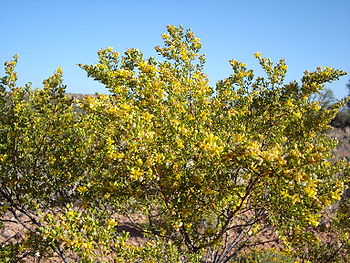Chaparral
From Wikiwel
Other Names: Creosote Bush, Créosotier, Greasewood, Hediondilla, Jarilla, Larrea divaricata, Larrea tridentata, Larreastat, Larrea mexicana, Zygophyllum tridentatum.
Chaparral is a plant. The leaf is used to make medicine, but there are serious safety concerns.
See also : Escharotic salves
Special Precautions of Chaparral
- Chaparral is UNSAFE. There are several reports of serious poisoning, acute hepatitis, and kidney and liver damage, including kidney and liver failure. There have been several cases where it caused liver damage from as early as three weeks from the start of use. Some cases even caused the need for emergency transplants.
- Chaparral can cause side effects including stomach pain, nausea, diarrhea, weight loss, fever, and liver and kidney damage. Putting chaparral on the skin can cause skin reactions including rash and itching.
- Pregnancy and breast-feeding: Chaparral is UNSAFE. It can cause serious liver and kidney problems. Don’t use products containing chaparral.
- Liver disease: Chaparral might make liver disease worse. Don’t use it.
- Medications that can harm the liver (Hepatotoxic drugs) interacts with Chaparral.
- The U.S. Food and Drug Administration and Health Canada have advised consumers against using products containing chaparral due to safety concerns. Despite warnings, chaparral is still available in the U.S. Chaparral is not permitted by Health Canada because it is not an authorized natural health product. Chaparral is sometimes an ingredient in diluted homeopathic preparations. The safety concerns do no generally apply to homeopathic preparations containing chaparral due to the extreme dilutions.
Benefits and uses of Chaparral are
- Arthritis.
- Cancer : Ingrediënt of Cansema (also known as black salve). Chaparral contains powerful antioxidants that resist irritation and NDGA which is known to fight histamine response. NDGA inhibits aerobic and anaerobic glycolysis (the energy-producing ability) of cancer cells.
- Sexually transmitted diseases.
- Tuberculosis.
- Colds.
- Skin conditions.
- Stomach problems (cramps, gas).
- Weight loss.
- Urinary and
- respiratory infections : Chaparral, a plant native to the Southwest, has been appreciated by the Native Americans for lung detoxification and respiratory support. Chaparral contains powerful antioxidants that resist irritation and NDGA which is known to fight histamine response. NDGA inhibits aerobic and anaerobic glycolysis (the energy-producing ability) of cancer cells. Chaparral is also a herb that fights harmful organisms. The benefits of chaparral are mostly available in a tincture extraction but chaparral tea may support respiratory problems by encouraging an expectorant action to clear airways of mucus.
- Chickenpox.
